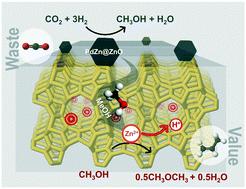当前位置:
X-MOL 学术
›
Catal. Sci. Technol.
›
论文详情
Our official English website, www.x-mol.net, welcomes your feedback! (Note: you will need to create a separate account there.)
On the conversion of CO2 to value added products over composite PdZn and H-ZSM-5 catalysts: excess Zn over Pd, a compromise or a penalty?
Catalysis Science & Technology ( IF 5 ) Pub Date : 2020-06-16 , DOI: 10.1039/d0cy00440e Christian Ahoba-Sam 1, 2, 3, 4, 5 , Elisa Borfecchia 2, 6, 7, 8, 9 , Andrea Lazzarini 1, 2, 3, 4, 5 , Aram Bugaev 10, 11, 12, 13, 14 , Abdulrahman Adamu Isah 15, 16, 17, 18, 19 , Mostafa Taoufik 15, 16, 17, 18, 19 , Silvia Bordiga 1, 2, 3, 4, 5 , Unni Olsbye 1, 2, 3, 4, 5
Catalysis Science & Technology ( IF 5 ) Pub Date : 2020-06-16 , DOI: 10.1039/d0cy00440e Christian Ahoba-Sam 1, 2, 3, 4, 5 , Elisa Borfecchia 2, 6, 7, 8, 9 , Andrea Lazzarini 1, 2, 3, 4, 5 , Aram Bugaev 10, 11, 12, 13, 14 , Abdulrahman Adamu Isah 15, 16, 17, 18, 19 , Mostafa Taoufik 15, 16, 17, 18, 19 , Silvia Bordiga 1, 2, 3, 4, 5 , Unni Olsbye 1, 2, 3, 4, 5
Affiliation

|
A challenge in converting CO2 into hydrocarbons (HC) via methanol (MeOH) is the gap between the optimal temperature for each step (i.e. ≤250 °C for MeOH and ≥350 °C for HC). The focus of this study is to elucidate the cause of the limitations associated to oxygenate and hydrocarbon formation in combined PdZn and H-ZSM-5 catalysts at 250 to 350 °C. Starting with two different chemical states of Pd and Zn from two preparation approaches (physical mixture and surface organometallic chemistry grafting), operando X-ray absorption spectroscopy (XAS) and powder X-ray diffraction (PXRD) studies revealed similar PdZn alloy active phase formed during pretreatment in flowing H2/Inert at 400 °C. The physical mixture performed better than the grafted analogue, with up to 8.8% yield to oxygenates (MeOH and dimethyl ether (DME); MeOH+) at 300 °C, close to the estimated thermodynamic yield (9.0%). The space–time yield (STY) of oxygenates increased from 250 to 300 °C, reaching 8.5 mol(MeOH+) kg(PdZn)−1 h −1. The catalyst performance surpassed other reported yields in similar systems, which activity declined with temperature even below 300 °C. Operando XAS and PXRD experiments further showed that the PdZn phase active for MeOH formation was maintained during testing in the 250–350 °C range. InfraRed (FT-IR) and XAS experiments revealed the poisoning of Brønsted acid sites in H-ZSM-5 by Zn(II) exchange, thereby rendering it inactive for hydrocarbon formation. Overall, to avoid biasing the hybrid catalyst performance, a careful and balanced choice of the compositional characteristics will be crucial in designing an improved multi-functional catalytic system for CO2 valorisation.
中文翻译:

在复合PdZn和H-ZSM-5催化剂上将CO2转化为增值产品时:Zn相对Pd而言过量,是折中还是不利?
通过甲醇(MeOH)将CO 2转化为碳氢化合物(HC)的一个挑战是每个步骤的最佳温度之间的差距(即MeOH≤250°C,HC≥350°C)。这项研究的重点是阐明在250至350°C下PdZn和H-ZSM-5组合催化剂中与氧化物和碳氢化合物形成相关的限制原因。从两种制备方法(物理混合物和表面有机金属化学接枝)开始,Pd和Zn具有两种不同的化学状态,操作X射线吸收光谱(XAS)和粉末X射线衍射(PXRD)研究表明形成了相似的PdZn合金活性相在预处理过程中流动的H 2/在400°C下惰性。物理混合物的性能优于接枝类似物,在300°C下含氧化合物(MeOH和二甲醚(DME); MeOH +)的产率高达8.8%,接近估算的热力学产率(9.0%)。含氧化合物的时空产率(STY)从250升高至300°C,达到8.5 mol (MeOH +) kg (PdZn)-1 h -1。在类似的系统中,催化剂的性能超过了其他报道的产率,甚至在低于300°C的温度下,活性也下降了。Operando XAS和PXRD实验进一步表明,在250–350°C范围内的测试过程中,对甲醇形成有效的PdZn相得以保持。红外(FT-IR)和XAS实验表明Zn(II)污染了H-ZSM-5中布朗斯台德酸位)交换,从而使其对烃的形成失去活性。总体而言,为避免偏倚杂化催化剂的性能,在设计用于CO 2气化的改进型多功能催化体系时,对组成特征进行仔细而平衡的选择至关重要。
更新日期:2020-07-06
中文翻译:

在复合PdZn和H-ZSM-5催化剂上将CO2转化为增值产品时:Zn相对Pd而言过量,是折中还是不利?
通过甲醇(MeOH)将CO 2转化为碳氢化合物(HC)的一个挑战是每个步骤的最佳温度之间的差距(即MeOH≤250°C,HC≥350°C)。这项研究的重点是阐明在250至350°C下PdZn和H-ZSM-5组合催化剂中与氧化物和碳氢化合物形成相关的限制原因。从两种制备方法(物理混合物和表面有机金属化学接枝)开始,Pd和Zn具有两种不同的化学状态,操作X射线吸收光谱(XAS)和粉末X射线衍射(PXRD)研究表明形成了相似的PdZn合金活性相在预处理过程中流动的H 2/在400°C下惰性。物理混合物的性能优于接枝类似物,在300°C下含氧化合物(MeOH和二甲醚(DME); MeOH +)的产率高达8.8%,接近估算的热力学产率(9.0%)。含氧化合物的时空产率(STY)从250升高至300°C,达到8.5 mol (MeOH +) kg (PdZn)-1 h -1。在类似的系统中,催化剂的性能超过了其他报道的产率,甚至在低于300°C的温度下,活性也下降了。Operando XAS和PXRD实验进一步表明,在250–350°C范围内的测试过程中,对甲醇形成有效的PdZn相得以保持。红外(FT-IR)和XAS实验表明Zn(II)污染了H-ZSM-5中布朗斯台德酸位)交换,从而使其对烃的形成失去活性。总体而言,为避免偏倚杂化催化剂的性能,在设计用于CO 2气化的改进型多功能催化体系时,对组成特征进行仔细而平衡的选择至关重要。



























 京公网安备 11010802027423号
京公网安备 11010802027423号